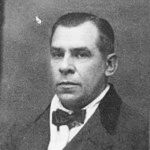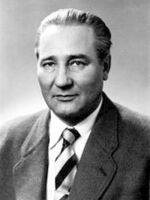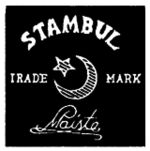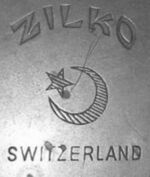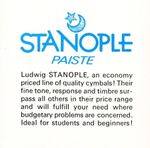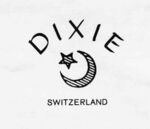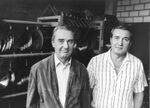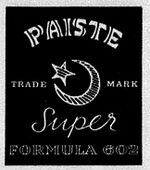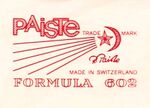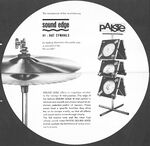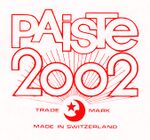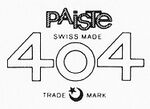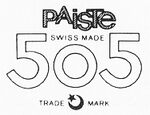Difference between revisions of "12""
| Line 1: | Line 1: | ||
| − | ===Paiste production history | + | ===Paiste production/history timeline=== |
__NOEDITSECTION__ | __NOEDITSECTION__ | ||
<div style="float:right">__TOC__</div> | <div style="float:right">__TOC__</div> | ||
Revision as of 20:48, 14 September 2021
Paiste production/history timeline
Contents
- 1 Paiste production/history timeline
- 2 1901-1916: Russia
- 3 1917-1939: Estonia
- 4 1932 - 1978?: STAMBUL series
- 5 1935 - 1960/1969?: ZILKO series
- 6 1945: German production facility
- 7 1949: Chinese Cymbal
- 8 1950: STANOPLE series
- 9 1954?-1978: DIXIE series
- 10 1957: Swiss production facility
- 11 1957 - 1973?: "Ludwig", "Ludwig Standard" series, Sales/distribution in the U.S.
- 12 1957-1964: Standard series
- 13 1957-1959: SUPER FORMULA 602
- 14 1959: FORMULA 602
- 15 1960 - 1978: SUPER series
- 16 1963: CuSn8 "B8" bronze is born
- 17 1963: Chinese CymbalL with round bell
- 18 1965 - 1971: STAMBUL65
- 19 1967: GIANT BEAT
- 20 1967/1968
- 21 1971: The 2oo2
- 22 1975 Distribution in the U.S. by Rogers
- 23 1978: 4o4 series
- 24 1978: 5o5 series
- 25 1978: Sound creation series
- 26 1979: 101 series
- 27 1980: Invention of un-lathed cymbals: RUDE
- 28 1981: all series, end of the Black Label era
- 29 1981: North American distribution center (greater Los Angeles area)
- 30 1981: begin of the "colored labels"
- 31 1983: Expanded 2002 models
- 32 1984: colorsound series
1901-1916: Russia
Michail Toomas Paiste, composer and musician founded a sheet music publishing house and music shop in Saint Petersburg in 1901, which also made simple instruments and carried out repairs. His father was from Estonia and was a member of the Tsar's Guard. The business flourished very well for many years until the Russian Revolution forced it to close.
1917-1939: Estonia
Mikhail Toomas returned to his homeland and opened a new shop in Tallinn, the capital of Estonia.
This is also where the first cymbals for concert and brass music were designed and manufactured, the demand for PAISTE products increased.
In 1930, at the same time as the new trends in music, his son, Michail M. began making cymbals.
Michail M. chose the Turkish form of production and developed his own concept with which he gave the PAISTE cymbals a new sound direction. He quickly became the driving force behind the still small company and eventually took over the business.
In addition, Michail M. Paiste also developed the first PAISTE gongs that came into the market. His award-winning products, both the cymbals and gongs, soon had a very good international reputation, so he began exporting to Europe and the USA.
In 1945 Michail M. and his family fled Poland and settled in northern Germany near Rendsburg. Michail M. began to build up a cymbal and gong production for the third time.
At the beginning of the 50s he was able to reactivate the old business relationships and the export business began to flourish again.
1932 - 1978?: STAMBUL series
The STAMBUL enters the market in 1932.
One of Paiste's longest running series: The STAMBUL was an upper class cymbal for the era up to the Second World War and prior to the F602 release, where it took a second place position after 1959.
Stambul's are made of nickel silver "NS12" until approximately 1970, it was then produced from CuSn8 "B8" bronze until phase out and transition in to the 505 series in 1978.
Production timeline:
1932-1940 (Estonia)
1940-1945 (Poland)--relocation from WWII, small production
1945-1948 (Germany)--relocation from WWII, small production
1948-1957 (Germany)--expanded production once again
1957-197? (Switzerland & Germany)
1935 - 1960/1969?: ZILKO series
Paiste needs a beginner's cymbal: In 1935 Paiste launches the lower-priced ZILKO series, making it the first cymbal manufacturer in the world to offer more than one cymbal level of quality.
These new cymbals are made in Estonia from special brass MS63 (1935-1953), then in Germany from nickel silver "NS12" (1953-1960) as ZILKO STANDARD.
It is possible the line was discontinued in the 50s and then they revived the Zilko (and Zilket) name in the 60s for sales through Arbiter.
This would seem to make sense since the Zilko name doesn't seem to appear in any of the 60s Paiste catalogs.
1945: German production facility
Towards the end of the war, Michail M. and his family escaped Poland as refugees, bringing him to Northern Germany where, for the third time, he begins to produce cymbals and gongs.
The cymbals and gongs superior reputation help revive business relationships and ensure development of a robust export business throughout the Fifties.
Today all Paiste gongs and budget cymbal series (from ALPHA down to the 101 BRASS series) labeled: "Made in Germany" are manufactured in Schacht-Audorf near Rendsburg by approx. 30 employees.
1949: Chinese Cymbal
Paiste is the first company in the world to integrate Chinese cymbals into the setup of drummers for modern music.
1950: STANOPLE series
Paiste brings the STANOPLE series onto the market in 1950 (The 2009 Paiste timeline gives the start date as 1950, but the line isn't listed in any of the 1950s era catalogs we have in our possession.).
These cymbals are initially made in Germany, later in the new Swiss production facility. All evidence points to them being made from "NS12" until possibly the last couple years of production, there is evidence that some late model Stanoples were made from CuSn8 "B8" bronze.
The stamp has "STANOPLE, Made in Germany, Paiste" or "STANOPLE, Made in Switzerland, Paiste" under the crescent moon and star.
Stanoples are mainly offered in the USA, from 1959 through the distributor Ludwig Drum Company Chicago. We don't know exactly how long they were produced, but STANOPLE cymbals can be found listed in the Ludwig catalog until 1973.
1954?-1978: DIXIE series
The DIXIE series is a new entry-level series and the possible successor to the ZILKO series. DIXIE's are made of nickel silver "NS12", allegedly there are also some made of brass MS63 (CuZn37) as well.
The Dixie was introduced sometime in the latter part of the 1950s as a lower-priced NS12 series below the Stambul.
Production of the Dixie in Switzerland seems to have started in late 1958 and the line makes its first appearance in the 1959 Paiste (Swiss) Catalog.
According to Paiste's production timeline, the Dixie started in Germany in 1954 but recent discoveries seem to refute this beyond a shadow of a doubt.
At some point post-1966 (probably in or closer to 1970), the Dixies were upgraded to the new CuSn8 "B8" bronze.
DIXIE's were phased out and transitioned into the 404 series by 1978.
The logo doesn't contain the word “Paiste”, only “DIXIE” and the crescent moon with a star, below it: “Made in Germany” or “Switzerland”.
1957: Swiss production facility
In 1957 Michail M. founded a new production workshop in Switzerland with his two sons Robert and Toomas (the 3rd generation).
A new era began under the direction of Robert (* 1932) and Toomas (* 1939) and Nottwil, located on Lake Sempach in the district of Lucerne.
In 1970, a new factory was built next to the existing one. In 1995 Toomas took over the role of President from Robert.
Since 2003, the company is headed by Toomas’ son, Erik.
1957 - 1973?: "Ludwig", "Ludwig Standard" series, Sales/distribution in the U.S.
With its new production facility in Switzerland, Paiste intends to eliminate trade restrictions and enter international markets: The Ludwig Drum Company becomes the distributor for the US market.
This can be described as a great business success for Paiste: Ludwig had sold only Zildjian cymbals from their first catalog starting in 1912.
From 1957: a less expensive PAISTE series is offered in addition to the higher-quality Zildjian, under the name "Ludwig".
Ludwig cymbals are first made in Germany (still with the addition CHICAGO on the stamp), then later in Switzerland, all are made of nickel silver.
Around 1965, the Ludwig STANDARD series (with the new Ludwig STANDARD logo) were added to the catalog and these can be classified as an upscale entry-level line.
Ludwig STANDARD cymbals are initially made in Switzerland and then from 1960 onwards in Germany, they are also made of nickel silver.
By 1975 we see the Last appearance of Ludwig Standards in limited size options (probably leftovers after the companies parted ways).
1957-1964: Standard series
The "Standard" used Nickel Silver NS12(Nickel Silver alloy). It's likely that they were the lower budget line at the time, as Stambul was the higher quality line.
The official Paiste '09 timeline doesn't list a "Standard", yet there is a "Zilko Standard" around this time frame. We have proof of its existence from the cover of the 1957 catalog, which only identifies three lines: Super F602, Stambul and Standard, this was when the Swiss factory first opened.
1957-1959: SUPER FORMULA 602
Paiste had been experimenting with cymbals made of B20 bell bronze for quite a while, in 1957 this (new to Paiste) alloy first came onto the market under the name "SUPER FORMULA 602", the stamp of this series still looks very similar to the STAMBUL stamp.
It's likely that the "super 602" was more of a prototype development, which was refined over those 2 years.
1959: FORMULA 602
After two years of experimenting with B20 Bronze, the FORMULA 602 series saw the light of day in the cymbal world in 1959.
These traditional bronze cymbals offer something very special in terms of sound quality and refinement, they overshadow everything Paiste had produced until then.
The FORMULA 602 series, which has its roots in jazz and acoustic music, gave Paiste their first big wave of international fame.
Ludwig introduced and started distributing 602's in the North American market in 1967, this further increased Paiste's sales and exposure to the largest consumer market in the world.
1960 - 1978: SUPER series
It is believed that he SUPER was first made in Germany sometime between 1960 and 1964, after the Paiste Standard line was discontinued. The Swiss factory also made "NS12" Supers for a short period of time (1967-1971?) before both factories switched to B8 version starting sometime in 1971.
Production of the B8 Super ceased by 1974 in the Swiss factory, the cymbal was still available from the German factory until 1978 when it was replaced by the 101.
The name “Paiste” is not found in the logo, the word “SUPER” is to the left of the crescent moon and star and below it: “Made in Germany” and later “Switzerland”.
1963: CuSn8 "B8" bronze is born
In 1963 Paiste began to experiment with CuSn8, a bronze alloy with a high copper content (92% copper and 8% tin), also called B8.
In the 1970s, this somewhat more reddish alloy became known as "2oo2 bronze". The B8 alloy is more elastic and malleable than the traditional B20 bell bronze, it is also easier to work (roll, hammer, turn) than B20.
B8 has unique sonic qualities compared to any other alloy: the large amount of copper gives a "sweetness" to the fundamental pitch and overtones, a definitive high frequency "ring" is also present that cuts through and makes this alloy instantly recognizable to the trained ear. B8's sonic qualities are perfect for cutting through loud amplified music!
1963: Chinese CymbalL with round bell
For the first time in 1963 the “Turkish bell” is used in a China cymbal, again a Paiste innovation.
1965 - 1971: STAMBUL65
The Stambul ’65 was Paiste's first series entirely made of the B8 (2002 bronze) alloy.
Released in 1965, the series was an important development that paved the way for the groundbreaking Giant Beat line and subsequently, the crowning achievement of Paiste’s use of B8, the legendary 2002.
The majority of Stambul ‘65s were made in Nottwil, but it’s not uncommon to see examples from the German factory, especially the marching cymbals.
In addition to the emboss logo, Stambul ’65 made after 1971 will have a black ink Paiste logo and series name stamp at the 12 o’clock position above the bell and the red ink type stamp at 3 o’clock should be on examples, no matter the year of the production.
1967: GIANT BEAT
1967/1968
Invention of the wavy edge hi-hat bottom cymbal - Sound Edge hi-hats
Invention of the bell-less flat ride cymbal (originally called the "space sound")
1971: The 2oo2
Paiste's crowning achievement, thier pinnacle of B8 development: the 2002 series.
No other cymbal manufacturer has matched the refinement and sonic balance of this series using B8 alloy.
Over the last half century or more, Paiste's ability to produce top of the class sounding multiple lines of B8 cymbals will never be matched by any other manufacturer.
The most successful line of Paiste cymbals reflected in sales numbers, unrivalled by any other line. Top Rock 'n' Roll drummers of the '70's incorporated 2002s into their set ups; virtually every English rock drummer from that era used 2002's with few exceptions!
1975 Distribution in the U.S. by Rogers
After Ludwig's withdrawal, Rogers, or rather its owner (CBS), takes over the distribution in the USA.
You will only find the 2oo2 series listed in the Rogers 1976 catalog. Subsequently, the 1979 catalog listed the new SOUND CREATION series along with a very limited selection of the 404 series.
The Formula 602 series was listed as "special order only, 100 day turnaround", the new 505 series was not listed at all.
1978: 4o4 series
The successor to the Dixie series, Paiste 404s were released to the general public in 1978. It appears the line was first developed in the Swiss factory staring sometime in 1974.
The transition to the Brown Label silk screened logo likely begins in 1981.
1978: 5o5 series
The successor to the long-running Stambul series, Paiste 505s were released to the public in 1978 and slotted in under the 2002. It appears production of the line might of begun in the Swiss factory staring sometime in 1974. There are likely oddball sizes and types out there that were produced during the transition from the Stambul B8 line and cymbals with both a Stambul emboss and a 505 hand stamp logo exist.
505's were not available in the U.S until ~1981 when Paiste opened their North American distribution center, by then they had the printed "green stamp" logo along with an expanded selection of models and sizes.
1978: Sound creation series
1979: 101 series
The original 101 was an entry-level Nickel-Silver line made in Paiste's German factory replacing the SUPER as the company's low budget offering.
The 101s received an embossed logo with black ink type stamps for the first two years of production.
Starting in 1981, the cymbals got silk screened logos in a pretty teal color for the rest of the run. Paiste would later revive the 101 name for its budget brass cymbals.
1980: Invention of un-lathed cymbals: RUDE
1981: all series, end of the Black Label era
1981: North American distribution center (greater Los Angeles area)
In 1981, Paiste gained a foothold in the world's largest music market in the world with the founding of Paiste America, Inc. in Brea, California (north east of Los Angeles).
Toomas lived in the U.S. (possibly Yorba Linda, close to the dist. center) for some time in the 80s and was instrumental in founding and developing the sales/distribution branch.
1981: begin of the "colored labels"
1983: Expanded 2002 models
1984: colorsound series
Return to the Paiste Series Portal
Return to the Paiste Cymbal Type Portal
